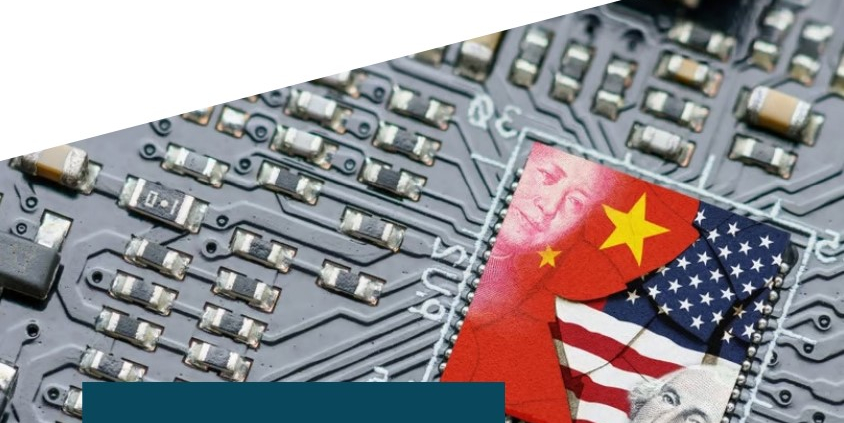The Implications of the US-China Technology War on Global South Digital Divide: Is It for the Better or the Worse?
The affinity between the United States and China has been unsteady; both have had the most critical and complex bilateral relationship throughout history. This affiliation is growing worse over the years, especially when China started gaining ground in competition over the dominant position in the global economy and political system. In this digital age, the game between the two countries is more than just a trade war. Recently, technology has become the core issue of the rivalry between the US and China, and even the term Tech War has been formalized in official US documents (Danilin, 2021). In this article, I argue that the US-China Technology War has significantly strengthened China’s technological existence in Global South, which led to a more considerable opportunity to reduce the digital divide within South countries.
Technology War: To What Extent?
By 2010, China has successfully grown into a substantial low-cost manufacturing site for global mass tech and electronic goods (Allison et al., 2021). Even world giant tech companies, such as Apple, Google, and Microsoft, established their production and assembly centers in China, primarily due to the availability of high-skilled workers. However, China has never been envisioned as a key player in technology development. According to China Scholar William Kirby (2014), many believed that China could only imitate and not innovate because advanced technology could only be made in a free society and not under an authoritarian regime. Apparently, this view needs to be revised as less than a decade later, China has incarnated into a significant competitor not only in high-tech sectors but also in 21st-century indispensable technology: artificial intelligence (AI); 5G; quantum information science; semiconductors; biotechnology; and green energy (Allison et al., 2021). Through Made in China 2025, Xi Jinping seems eager and ready to cut the heavy reliance on Western technology and move forward as a global powerhouse of the high-tech producer.
China’s rising technology eventually concerns the US government. Since the Barack Obama Presidency, the United States has launched several precautions to prevent China from investing more in the US semiconductor industries and gradually cut China’s access to US technology (Sun, 2019). This concern was aggressively addressed during the Trump Administration by shifting the US approach from an engagement-based approach to a competition-based one (Campbell & Ratner, 2018; Friedberg, 2018). Washington is apparent to go all out impending Beijing to gain more ground in technological advancement by releasing a Whole-Of-Government strategy. In order to push back against China, the US imposed technological sanctions on leading Chinese high-tech companies, accusing them of doing illegal technology transfers. Various executive and legislative branches started taking action to put pressure on the Chinese Government to resolve unfair acts, policies, and practices regarding the same issue (Mori, 2019). Further, Trump Administration was also reforming Foreign Investment Risk Review Modernization Act of 2018 which affecting Beijing’s investment in the US and, at the same time, tightening export of technology to China.
The Tech War launched by the Trump Presidency showed how technology had become a significant factor in international relations today, particularly in defining power. In the past decades, technological developments are only centered in the Global North, mainly in the United States. The US has not only become the axis of innovation but also dominates the segment of industries related to technology production, including the semiconductor market, logic chip system, analog semiconductor system market, and equipment for semiconductor production (Danilin, 2021). The US intellectual property is likely to be present in almost every key technology product. For a long time, Global South countries, including China, have depended heavily on the US for this particular sector. The ambition of Xi Jinping necessarily posed impendence towards this status quo of US domination and sovereignty over technology.
Nevertheless, amid the Tech War, China demonstrated strong resistance, which can be seen from the growing China’s share of global ICT exports, which amounted to 43.37 percent by 2020 (Danilin, 2021). Additionally, Tech War does not seem to hinder the expansion of 5G technology and China’s existence in the Global South. Through the Digital Silk Road Project, part of the Belt and Road Initiative (BRI), Beijing has become a key actor in building digital infrastructure. In this case, the ambition of China looks promising to address the digital divide issue in Global South.
Tech War and Global South Digital Divide
Building up digital infrastructures is challenging in the region with limited capital and lower technological proficiency, which is mostly the case in South countries. Amid the tremendous pace of technological advancement, the Global South has become the group with more homework in the digitalization pipeline. Besides considering digital inclusivity, which is still relatively low, South countries also have to deal with digital infrastructure, which would need huge capital investment. Heavy reliance on the Global North technology is not helping as well in this matter. With the center of technology development being in the Global North, a digital divide is visible within the North-South relationship, where the South is the market with limited capability to build digital infrastructure using their technology. The ambition of the Xi Jinping government to take over the US dominance over technology could be a turning point in this strained relationship. In addition, the pressure exerted by the US in the so-called Tech War has also made China more aggressive in strengthening its technological presence in Global South which is carried out through Digital Silk Road.
China’s investment through Digital Silk Road (DSR) has filled the gap in digital infrastructure development in Global South. Around 138 countries have been joining the DSR projects, and since 2013, China has become a key player in establishing a digital backbone for numerous South countries: from the establishment of data centers and a smart city in Kenya to a pilot project for 5G in Thailand and e-commerce platform in Malaysia (Kurlantzick, 2020; Russel & Berger, 2021). Chinese giant tech Huawei has operated in more than 150 countries, primarily providing 5G connections in Asia and Africa (Hillman, 2021). Hikvision and Dahua hold almost 40 percent world’s surveillance cameras, and Hengtong Group provides 15 percent of global fiber optics demands (Hillman, 2021). China is also deepening its ICT engagement with various African countries and actively promoting digital government with developing and emerging nations. Huawei and ZTE have played a prominent role in contriving digital infrastructures in Southeast Asia, such as Indonesia, Laos, and Vietnam.
Further, China’s technological devices, such as handphones and laptops, produced by Huawei, Xiaomi, and Oppo, provide enormous opportunities for middle and lower-class society in multiple South countries to access technology. It became apparent how DSR Projects have enabled Global South to adopt digital environments faster and at considerably cheaper prices suited to capital situations in the regions. This agenda also shows how China’s presence has begun gradually breaking the Global South’s dependence on the Global North technology. By carrying out the principle of knowledge transfer in every project (Heidbrink & Becker, 2022), a more robust China’s technological presence in Global South due to the US-China Tech War could be a significant factor in alleviating the Global South digital divide.
References
Abrami, R. M., Kirby, W. C., & McFarlan, F. W. (2014). Why China Can’t Innovate. Harvard Business Review. https://hbr.org/2014/03/why-china-cant-innovate
Allison, G., Klyman, K., Barbesino, K., & Yen, H. (2021). The Great Tech Rivalry: China vs the U.S.
Campbell, K. M., & Ratner, E. (2018). The China Reckoning: How Beijing Defied American Expectations. Foreign Affairs, 60–70.
Danilin, I. v. (2021). The U.S.-China Technological War. Russia in Global Affairs, 19(4), 78–97. https://doi.org/10.31278/1810-6374-2021-19-4-78-96
Friedberg, A. L. (2018). Competing with China. Survival, 60(3), 7–64.
Heidbrink, C., & Becker, C. (2022). Framing the Digital Silk Road’s (De)Securitisation. Journal of Current Chinese Affairs, 186810262211175. https://doi.org/10.1177/18681026221117567
Kurlantzick, J. (2020, December 18). Assessing China’s Digital Silk Road Initiative: Transformative Approach to Technology Financing or Danger to Freedom. Council on Foreign Relations. https://www.cfr.org/china-digital-silk-road/
Mori, S. (2019). US Technological Competition with China: The Military, Industrial and Digital Network Dimensions. Asia-Pacific Review, 26(1), 77–120. https://doi.org/10.1080/13439006.2019.1622871
Russel, D. R., & Berger, B. H. (2021). Stacking the Deck: China’s Influence in International Technology Standard Setting.
Sun, H. (2019). U.S.-China Tech War. China Quarterly of International Strategic Studies, 05(02), 197–212. https://doi.org/10.1142/S237774001950012X
.










Leave a Reply
Want to join the discussion?Feel free to contribute!